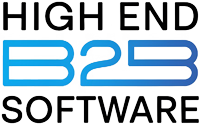Running a small business today means juggling operations, marketing, client communication, and more. The good news? You no longer need to hire a developer or learn to code just to automate tasks. Thanks to powerful no-code data automation tools, small businesses can now streamline workflows, collect and organize data, and trigger actions automatically—without touching a single line of code. no-code data automation tools.
Whether you want to sync your Google Sheets with your CRM, auto-send Slack messages from new email inquiries, or generate reports in real-time, these platforms make it effortless.
Let’s dive into the best no-code data automation tools every small business should consider in 2025.
1. Zapier – The Gold Standard in No-Code Automation
Official Site: Visit Zapier
Zapier remains the go-to tool for businesses new to automation. It connects over 6,000+ popular apps like Gmail, Slack, Trello, Shopify, and Stripe. With its drag-and-drop interface, you can build “Zaps”—automated workflows that trigger actions across apps.
Key Features:
- Supports 6,000+ integrations
- Multi-step workflows with filters, paths, and delays
- Automations can trigger from almost any app event
- Built-in tools for email, formatting, scheduling, and more
Pros:
- Extensive app integrations
- Easy to use with a wide library of templates
- Active community and documentation
Cons:
- Can become expensive with more tasks
- Limited logic in the free plan
Best For: Small business owners who want to connect tools fast without coding. no-code data automation tools.
2. Make (Integromat) – Visual Workflow Builder for Data Pros
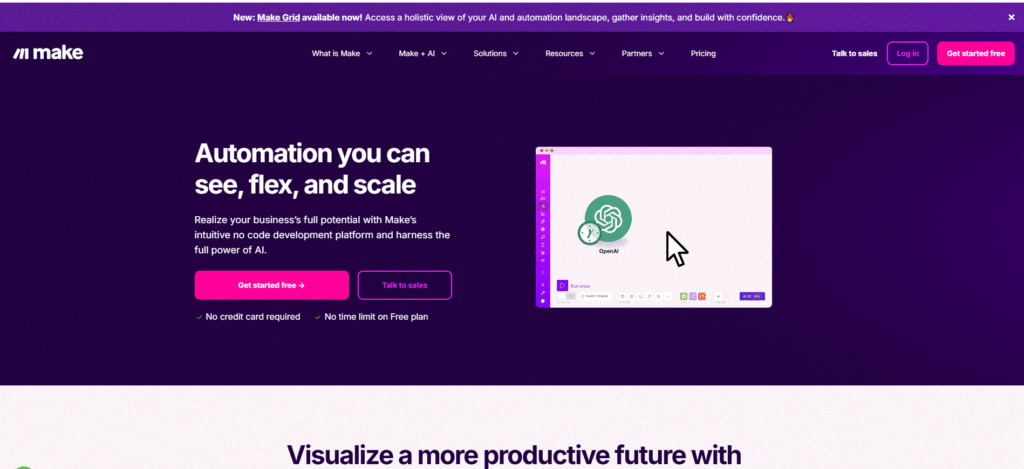
Official Site: Visit Make
Make offers an elegant, visual interface where you can drag and connect nodes for each step of a workflow. Ideal for teams dealing with complex data operations or multi-path logic.
Key Features:
- 1000+ supported apps
- Real-time automation visualization
- Supports variables, branching, looping
- Powerful error-handling logic
Pros:
- Advanced capabilities for complex flows
- Affordable pricing for robust use
- Realtime data monitoring
Cons:
- Learning curve for beginners
- Occasional interface glitches
Best For: Tech-savvy users and data-heavy small teams.
3. Pabbly Connect – Budget-Friendly with Unlimited Workflows
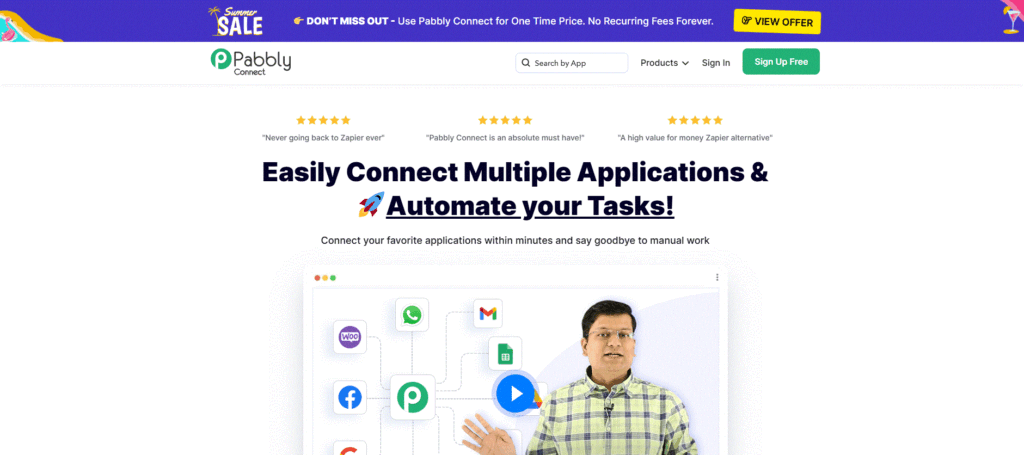
Official Site: Visit Pabbly
Pabbly Connect offers many of the same features as Zapier but at a fraction of the price, including unlimited workflows on paid plans. Plus, their lifetime pricing model is popular among startups.
Key Features:
- Unlimited tasks and workflows
- Webhooks, routers, delays, and filters
- Integrates with Stripe, Google Apps, Calendly, etc.
- Workflow cloning and scheduling
Pros:
- Cost-effective plans with no task limits
- Growing integration library
- Clean user interface
Cons:
- Slower support compared to larger platforms
- Fewer third-party tutorials
Best For: Budget-conscious businesses looking for automation flexibility.
4. Airtable Automations – Spreadsheets on Steroids

Official Site: Visit Airtable
Airtable merges the simplicity of spreadsheets with the power of databases. Now with native automation, it can trigger emails, messages, updates, and more based on data inputs.
Key Features:
- Relational tables, forms, templates
- Native automations built into tables
- App-like interface with blocks and views
- Syncs across devices
Pros:
- Very intuitive for spreadsheet users
- Great collaboration tools
- Templates for various industries
Cons:
- Limited automation on free plan
- Can feel restrictive compared to full workflow tools
Best For: Teams managing structured data like inventory, clients, or tasks.
5. Parabola – No-Code Dataflow for Ecommerce & Ops
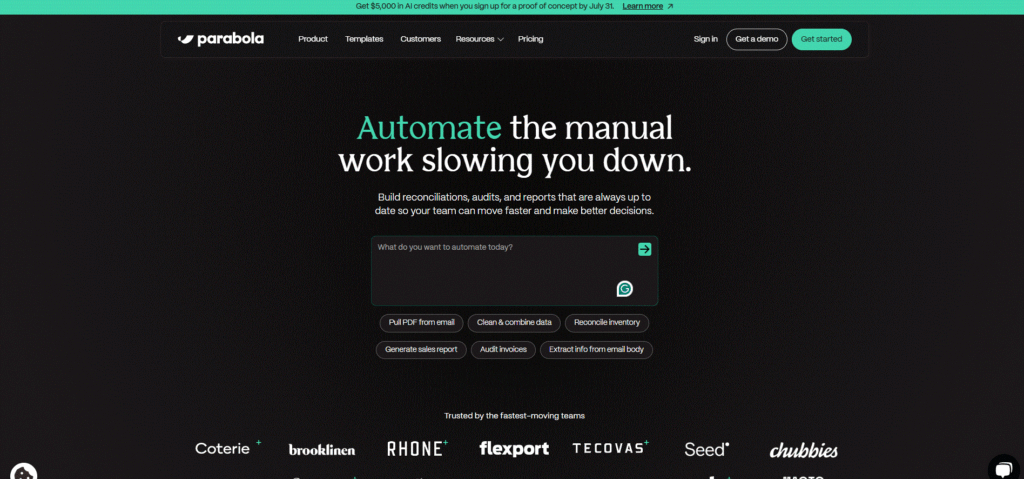
Official Site: Visit Parabola
Parabola is designed for operations and ecommerce teams that work heavily with CSVs, spreadsheets, and APIs. Its no-code flow builder makes it easy to process and clean data, run calculations, and auto-update dashboards or send outputs.
Key Features:
- Drag-and-drop flow editor for manipulating data
- Integrations with Shopify, Salesforce, Airtable, Google Sheets
- Real-time data syncing
- Ideal for inventory updates, order exports, and reporting
Pros:
- Designed for non-technical teams
- Handles complex data easily
- Reusable flows and automation templates
Cons:
- Higher cost for advanced features
- Steeper learning curve for basic users
Best For: Ecommerce brands, marketplaces, and data-heavy workflows.
6. Tallyfy – Automate Approval-Based Workflows
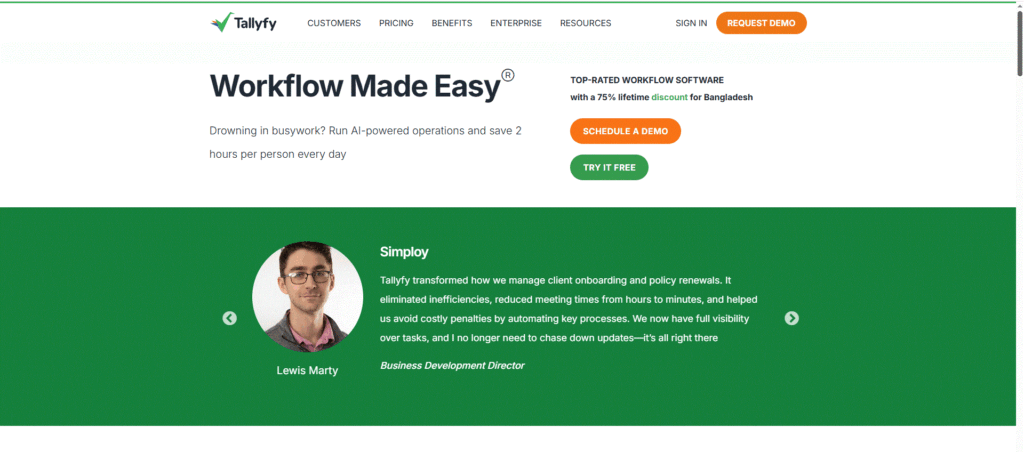
Official Site: Visit Tallyfy
Tallyfy is purpose-built for approvals, onboarding, and repetitive processes in growing small businesses. Its no-code interface allows you to automate standard operating procedures (SOPs), client onboarding checklists, and task approvals across teams—without needing IT.
Key Features:
- One-click approvals, forms, and SOPs
- Powerful conditional logic
- Assign tasks to roles (not just individuals)
- Real-time status tracking for all processes
Pros:
- Easy setup for recurring processes
- Great for scaling business operations
- Built-in documentation and SOP templates
Cons:
- Integrations not as broad as Zapier
- Pricing scales with team size
Best For: Service-based businesses with approval-heavy workflows (e.g., HR, legal, client onboarding)
7. N8N – Open-Source Automation with No-Code UX
Official Site: Visit N8N
n8n is a self-hosted, open-source alternative to Zapier and Make, giving you full control over your workflows and data. It offers a sleek no-code editor and supports hundreds of integrations. Perfect for businesses that need privacy, flexibility, and customization.
Key Features:
- Open-source + self-hosted option
- Drag-and-drop editor for workflows
- Built-in conditional logic, loops, webhooks
- Advanced error handling and logging
Pros:
- No limits on tasks or executions
- Custom node creation for niche use cases
- Cost-effective for growing businesses
Cons:
- Requires initial setup (especially for self-hosted)
- Not as user-friendly for beginners
Best For: Privacy-focused small teams, tech startups, or agencies wanting full control
8. Unito – Deep Two-Way Sync for Apps
Official Site: Visit Unito
Unito goes beyond simple triggers. It offers real-time, two-way data sync between your tools like Trello, Asana, HubSpot, ClickUp, and more—making it invaluable for teams who need to collaborate across platforms without duplicating work.
Key Features:
- Sync tasks, projects, data across tools
- Filter and map fields between apps
- Visual workflow builder
- Pre-built connectors for PM, CRM, and dev tools
Pros:
- True two-way sync (not just triggers)
- Great for remote and cross-functional teams
- Powerful customization filters
Cons:
- Premium pricing tiers
- Limited to supported tools (no custom app connections)
Best For: Cross-functional teams using multiple project management or CRM tools
9. Bardeen – Automate Browser-Based Workflows
Official Site: Visit Bardeen
Bardeen lets you automate tasks directly inside your browser, from copying data off websites to saving LinkedIn leads into a CRM. It’s great for scrapers, marketers, and anyone using Chrome as their daily dashboard.
Key Features:
- Chrome extension-based automation
- “Autobookmarks” & scraping templates
- Pre-built playbooks for marketing, HR, research
- Works with Notion, Airtable, Gmail, LinkedIn, etc.
Pros:
- Automates real-world browser behavior
- Ideal for researchers and outreach teams
- No backend setup needed
Cons:
- Limited to browser-based workflows
- Advanced tasks may need scripting support
Best For: Marketers, recruiters, and sales teams automating online research or lead generation
10. Levity – No-Code AI Workflow Automation
Official Site: Visit Levity
Levity brings AI into no-code automation. It lets you create custom machine learning models to classify images, emails, or documents—and then trigger workflows based on predictions. Think: sorting support tickets, tagging products, or flagging compliance issues—all without writing code.
Key Features:
- Train AI models with your own data
- Works with email, documents, images
- Integrates with Airtable, Gmail, Zapier
- Drag-and-drop builder with conditional flows
Pros:
- Brings AI capabilities to non-tech users
- Smart automation based on patterns, not just triggers
- Easy interface for training models
Cons:
- Takes time to train models properly
- Not ideal for quick “if-this-then-that” automations
Best For: Teams that need to process unstructured data (e.g., customer support, HR, or ecommerce product categorization)
Comparison Table: No-Code Data Automation Tools
| Tool | Interface & Ease | Integrations | Pricing (Starting) | Best For |
|---|---|---|---|---|
| Zapier | Clean & intuitive | 6,000+ apps | $19.99/mo | Beginners, general automation |
| Make | Visual drag builder | 1,000+ apps | $9/mo | Data pros, multi-step workflows |
| Pabbly Connect | Simple & effective | 1,000+ apps | Lifetime or $19/mo | Budget-conscious teams |
| Airtable | Spreadsheet-style UI | Native + APIs | Free, Pro $10/mo | Client/inventory/task databases |
| Parabola | Drag-and-drop flows | Ecom APIs, CSVs | $80/mo | Ecommerce, ops automation |
| Stacker | App-style interface | Airtable, Sheets | $59/mo | Internal tools & dashboards |
| Tally | Form-based logic | Zapier, Webhooks | Free, Paid $29/mo | Data collection with logic |
| N8N | Flow builder | 300+ APIs | Free (self-hosted) | Dev-friendly privacy-first users |
| Bardeen | Chrome + AI UI | Notion, Sheets | Free | Founders, creators, workflow triggers |
| AppSheet | App-like UI builder | Sheets, Forms | Free, Paid $5+/mo | Creating mini data apps |
(FAQ) For no-code data automation tools
Can I automate my business without any coding knowledge?
Yes! That’s the beauty of no-code platforms like Zapier or Make. You just connect blocks, choose triggers, and let the tool handle the rest—no tech skills needed.
Which is the best no-code automation tool for solo founders?
Zapier is beginner-friendly and has the largest integration library. But if you want visual logic paths, go for Make.
What if I outgrow no-code tools?
Some platforms like Make, Parabola, or n8n offer dev-grade functionality. And most tools allow scaling or API extensions if you need to go deeper.
Is Pabbly Connect really a one-time payment?
Yes, they often offer lifetime plans, which makes them extremely attractive for startups or side hustlers. Always check their current deal page.
Are these tools safe to use for sensitive data?
Reputable platforms like Zapier, Make, and Airtable follow GDPR and SOC2 practices. But always verify data privacy settings before using them for sensitive info.
Final Thoughts: Which No-Code Data Automation Tool Is Right for You?
In 2025, no-code data automation tools have gone from being nice-to-haves to business essentials. Whether you’re a solo entrepreneur tired of repetitive tasks or a growing team trying to scale smarter, these tools can save you hours each week, reduce manual errors, and help you focus on high-value work. no-code data automation tools.
If you’re after flexibility and 6,000+ integrations: Zapier is a safe bet.
On a budget and need unlimited workflows? Go with Pabbly Connect.
Want advanced logic with visual flow-building? Try Make (Integromat).
Need structured data + automation in one place? Use Airtable.
Ecommerce or ops-heavy? Parabola or Stacker is your friend.
Also check: Best No-Code Automation Platforms for Small Business
